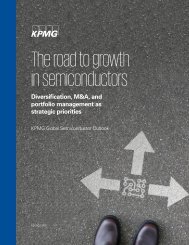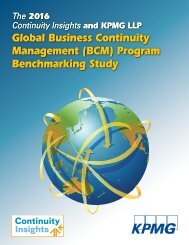Revenue for Telecoms
2cdncba
2cdncba
Create successful ePaper yourself
Turn your PDF publications into a flip-book with our unique Google optimized e-Paper software.
154 | <strong>Revenue</strong> <strong>for</strong> <strong>Telecoms</strong> – Issues In-Depth<br />
| 8 Customer options <strong>for</strong> additional goods or services<br />
Exercise of a material right<br />
When a customer exercises a material right <strong>for</strong> additional goods and services, a<br />
telecom entity may account <strong>for</strong> it using one of the following approaches.<br />
– Continuation of the original contract: Under this approach, a telecom entity<br />
treats the consideration allocated to the material right as an addition to the<br />
consideration <strong>for</strong> the goods or services under the contract option – i.e. as a<br />
change in the transaction price.<br />
– Contract modification: Under this approach, a telecom entity applies the<br />
contract modification guidance to evaluate whether the goods or services<br />
transferred on exercise of the option are distinct from the other goods or<br />
services in the contract. The outcome of this evaluation will determine whether<br />
the modification is accounted <strong>for</strong> prospectively or with a cumulative catch-up<br />
adjustment.<br />
In telecom consumer contracts, the optional goods or services would typically<br />
be distinct from those promised in the original contract. There<strong>for</strong>e, the outcome<br />
under either approach will be similar and prospective.<br />
Material rights do not extend the term of a contract<br />
A right to renew a contract may create a material right (i.e. because there is an<br />
incentive <strong>for</strong> the customer to renew the contract). This material right may be<br />
recognized in a period beyond the contract’s initial term. However, the existence<br />
of a material right does not extend the term of the contract, which is defined by<br />
the en<strong>for</strong>ceable rights and obligations (see Section 2).<br />
Comparison with current IFRS<br />
Treatment of customer loyalty programs broadly similar to current practice<br />
[IFRIC 13]<br />
The current IFRS guidance on customer loyalty programs is broadly similar to the<br />
guidance in the new standard.<br />
However, a telecom entity needs to consider whether the allocation method that<br />
it currently applies remains acceptable under the new standard. Under current<br />
IFRS, a telecom entity can choose which method it wants to use to allocate the<br />
consideration between the sales transaction and the award credits, and many use<br />
the residual method to estimate the stand-alone selling price of award credits.<br />
By contrast, under the new standard the residual approach can only be applied if<br />
certain criteria are met.<br />
Home<br />
© 2016 KPMG LLP, a Delaware limited liability partnership and the US member firm of the KPMG network of<br />
independent member firms affiliated with KPMG International Cooperative, a Swiss entity. All rights reserved.<br />
© 2016 KPMG IFRG Limited, a UK company, limited by guarantee. All rights reserved.







